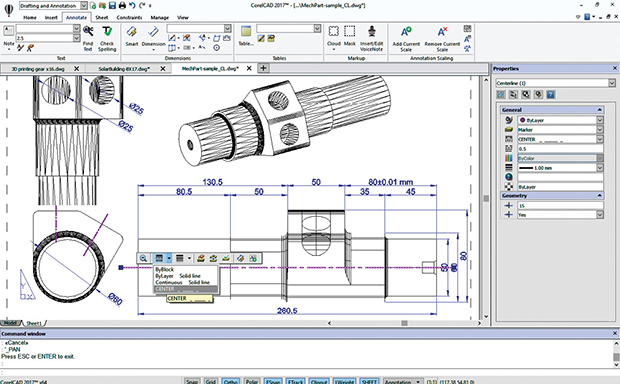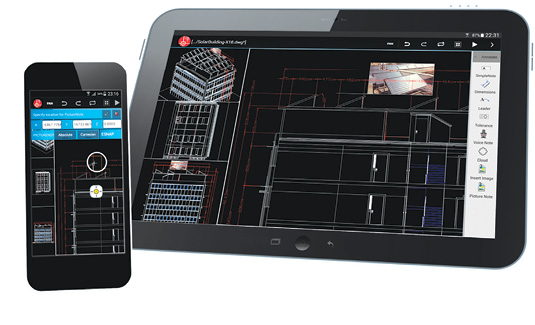
CorelCAD 2017 adds a new centerline command. When you switch to its Drafting and Annotation workspace, its interface looks much like AutoCAD.
Latest News
March 30, 2017
Corel has been around a long time. The Canadian software company’s CorelDRAW software, introduced in 1989, was one of the first graphics programs available for Windows—and at one time Corel was the biggest software company in Canada. More recently, Corel has acquired numerous programs in markets including design, illustration, photo editing and video editing.
The company recently released CorelCAD 2017, the sixth version of its 2D/3D CAD software. CorelCAD is built using the ARES CAD kernel from German developer Graebert. That same CAD engine powers Graebert’s own ARES Commander and Dassault Systèmes’ DraftSight software.
CorelCAD is positioned as a low-cost alternative to AutoCAD and uses DWG as its own native CorelCAD file format, specifically the R2013 DWG format used by all versions of AutoCAD from 2013 through 2017. CorelCAD 2017 is available for Windows, Mac OS and Android tablets.
 CorelCAD 2017 adds a new centerline command. When you switch to its Drafting and Annotation workspace, its interface looks much like AutoCAD.
CorelCAD 2017 adds a new centerline command. When you switch to its Drafting and Annotation workspace, its interface looks much like AutoCAD.Familiar Interface
When you first start CorelCAD, the program displays its “classic” user interface that includes pull-down menus and a host of toolbars with icon-only buttons docked around the perimeter of screen. But as soon as you switch to the “Drafting and Annotation” or “3D Modeling” workspaces—equivalent to similarly-named workspaces in AutoCAD—CorelCAD changes to a ribbon interface quite similar to that of AutoCAD.
Like AutoCAD, each drawing appears in its own window, identified by a file tab across the top of the drawing area. You can use the drawing file tabs to easily switch between drawings or start a new drawing and use tabs in the lower-left corner of the drawing window to switch between model space and multiple sheets—equivalent to paper space layouts in AutoCAD. In fact, some similarities between CorelCAD and AutoCAD are uncanny.
For example: CorelCAD has a command window and you can start commands by typing, just like AutoCAD. A few commands have different names—such as NOTE instead of MTEXT, and PATTERN instead of ARRAY—but thanks to command shortcuts, it really doesn’t matter.
Added Features
Although CorelCAD doesn’t include every function found in AutoCAD, the list of missing features has gotten smaller. For example, the program’s Quick Input feature—nearly identical to AutoCAD’s dynamic input—shows commands and options adjacent to the cursor. CorelCAD 2017 also now includes command auto-completion (nearly identical to the feature introduced in AutoCAD 2012).
CorelCAD 2017 also adds context-sensitive object grips, similar to extended tooltips in AutoCAD. When you hover the cursor over a grip, the program displays a contextual shortcut menu that speeds editing of existing geometry.
As in AutoCAD, you can define attributes and include them as part of a block. An extended block attribute editor, new in CorelCAD 2017, lets you modify attribute values, properties and text options for any block that has already been inserted into the drawing. Also new to CorelCAD 2017 is a split dimension command that can split dimension lines and extension lines where they cross other geometry.
Patterns along a path represent another new CorelCAD feature added to match similar functionality first introduced in AutoCAD 2012. In addition to creating copies of selected objects in a rectangular or circular pattern, CorelCAD 2017 users can create copies of specified objects along a spline, polyline, arc, circle or elliptical path. But unlike AutoCAD, patterns in CorelCAD are never associative. In AutoCAD, if you change the path, the objects in an associative array update. In CorelCAD, if you change the path, you will have to delete the copied objects and start again.
CorelCAD 2017 also introduces a centerline construction command, similar to the centerline tool introduced in AutoCAD 2017. When you start the command, the program prompts you to select two entities—which can be pairs of lines, arcs or polyline segments—and places a centerline between them. But, the resulting centerlines are not associative to the objects they annotate.
Other new features include a ChangeSpace command that enables you to move entities between model space and sheet workspaces. The program’s trimming tools have been enhanced to work with hatches as well as solid and gradient fills.
Compatibility and More
CorelCAD also offers some 3D modeling capabilities, which have not been significantly updated in the latest release. For example, you can create primitives such as solid boxes, wedges, cylinders and spheres. There are also tools to create some solid mesh objects, such as ruled, revolved and tabulated meshes. But CorelCAD lacks tools for creating mesh primitives and the program has no surface modeling capabilities. You can perform Boolean operations such as union, subtract and intersect to combine 3D objects, but you cannot use grips to change the size or shape of objects.
CorelCAD also provides surprisingly good support for AutoLISP as well as ARX. The program uses the same hatch patterns, linetypes and SHX text files as AutoCAD, so users should have no compatibility issues when exchanging drawing files.
CorelCAD actually offers some capabilities not found in AutoCAD. For example, you can insert audio recordings (called VoiceNotes) into a drawing. These recordings are embedded into the drawing and can be played back later. Although AutoCAD does not support VoiceNotes, it has no problem opening a drawing containing them and after resaving the drawing in AutoCAD, the VoiceNotes play fine when the file is opened again in CorelCAD.
CorelCAD also supports other industry-standard formats, including SVG, ACIS and SAT, enabling users to import files from other CAD programs. You can also export to PDF and include PDF files as underlays, but you cannot yet import PDF geometry into a CorelCAD drawing. Because it is developed by Corel, it makes sense that CorelCAD also provides links to other Corel software. You can import CorelDRAW and Corel DESIGNER files as model space objects and export CorelCAD drawings to both formats, but only in the Windows version. The CDR and DES formats are not supported on the Mac OS.
There remains a long list of AutoCAD features not available in CorelCAD, such as sheet sets, dynamic blocks and model documentation. But at $699, CorelCAD is much less expensive than AutoCAD or even AutoCAD LT. The fact that your CorelCAD purchase gets you a perpetual license may also be very attractive. AutoCAD is now available only on a subscription basis, whereas when you buy CorelCAD, your license never expires. You can also upgrade from any previous version of CorelCAD for $199. In addition, you can download CorelCAD Mobile for Android tablets and smartphones from the Google Play store (no iOS version at present). The mobile version offers 3D viewing and 2D editing of any CorelCAD drawing, and provides full functionality for the first 30 days. After that trial period, it converts to view-only mode. But CorelCAD 2017 licensed customers can continue to use the full mobile version for one year and pay $199 per year thereafter.
The similarities to AutoCAD—and its low cost—are definitely CorelCAD’s strengths. Although it lacks many of AutoCAD’s more advanced capabilities, CorelCAD offers an attractive alternative for those on a budget.
Subscribe to our FREE magazine, FREE email newsletters or both!
Latest News
About the Author
David Cohn is a consultant and technical writer based in Bellingham, WA, and has been benchmarking PCs since 1984. He is a Contributing Editor to Digital Engineering, the former senior content manager at 4D Technologies, and the author of more than a dozen books. Email at [email protected] or visit his website at www.dscohn.com.
Follow DE






